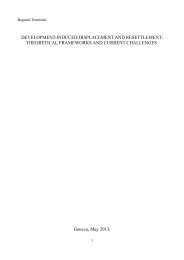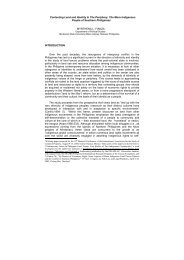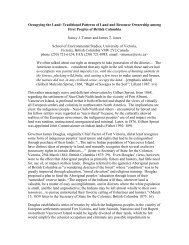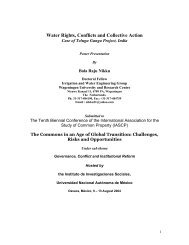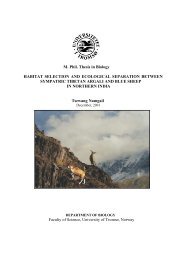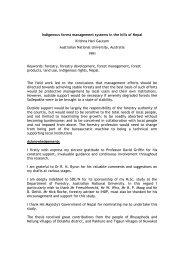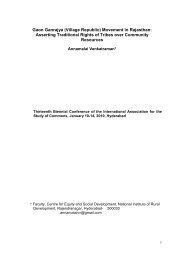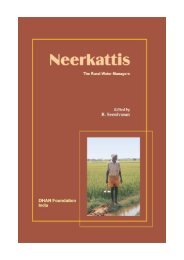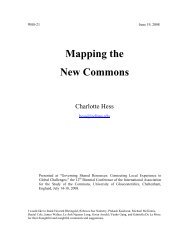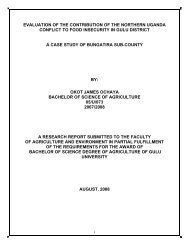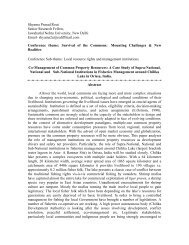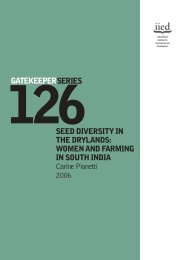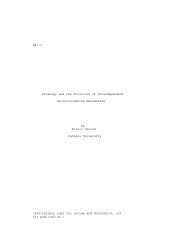The emergence of fisheries legislation and regulations in Zambia ...
The emergence of fisheries legislation and regulations in Zambia ...
The emergence of fisheries legislation and regulations in Zambia ...
You also want an ePaper? Increase the reach of your titles
YUMPU automatically turns print PDFs into web optimized ePapers that Google loves.
Hunt<strong>in</strong>g restrictions that are a common feature <strong>of</strong> game <strong>legislation</strong> were applied to <strong>fisheries</strong>.<br />
Restrictions through various means such as closed seasons <strong>and</strong> licens<strong>in</strong>g are meant to allow for<br />
selective removal <strong>of</strong> certa<strong>in</strong> specimen at particular times to avoid over-hunt<strong>in</strong>g. When extended<br />
to fish<strong>in</strong>g it is argued that closed seasons <strong>and</strong> licences are necessary because they limit the<br />
amount <strong>of</strong> fish to be harvested thereby prevent<strong>in</strong>g the depletion <strong>of</strong> fish resources (Jackson 1961).<br />
Another aspect <strong>of</strong> game laws that were transferred to the way fish was to be regulated is related<br />
to the protection <strong>of</strong> young specimen. This measure was meant to avoid the kill<strong>in</strong>g <strong>of</strong> young<br />
specimens as this would eventually lead to the ext<strong>in</strong>ction <strong>of</strong> a given species. It was necessary to<br />
only allow for the hunt<strong>in</strong>g <strong>of</strong> animals that had reached such an age that their removal would not<br />
have an impact on the ability <strong>of</strong> the rema<strong>in</strong><strong>in</strong>g specimens from replenish<strong>in</strong>g themselves. This<br />
<strong>legislation</strong> is comprehensible <strong>in</strong> that most game, especially those that the laws sought to protect,<br />
such as e.g. elephants, do not reproduce rapidly <strong>and</strong> <strong>in</strong> large numbers. Thus, when specific<br />
fish<strong>in</strong>g <strong>regulations</strong> began to emerge <strong>in</strong> <strong>Zambia</strong> <strong>and</strong> Zimbabwe there was emphasis on sett<strong>in</strong>g<br />
m<strong>in</strong>imum mesh sizes <strong>of</strong> fish<strong>in</strong>g nets <strong>and</strong> the admissible width <strong>of</strong> apertures <strong>in</strong> fish<strong>in</strong>g traps <strong>and</strong><br />
baskets. <strong>The</strong>se clauses on m<strong>in</strong>imum mesh-sizes were aimed at prevent<strong>in</strong>g the harvest<strong>in</strong>g <strong>of</strong><br />
f<strong>in</strong>gerl<strong>in</strong>gs. Other fish<strong>in</strong>g gear such as weirs were legislated aga<strong>in</strong>st because they were<br />
considered to be successful only if the fish move, <strong>and</strong> a fish moves, nearly always, under the<br />
impulse <strong>of</strong> its spawn<strong>in</strong>g migration (Jackson1961).<br />
Ideological reasons were also beh<strong>in</strong>d some <strong>of</strong> the <strong>regulations</strong> that emerged. As <strong>legislation</strong> for the<br />
conservation <strong>of</strong> game was emerg<strong>in</strong>g calls were made to proscribe certa<strong>in</strong> hunt<strong>in</strong>g methods<br />
considered to be ‘unfair’ to the hunted animal (Be<strong>in</strong>art <strong>and</strong> Coates 1995). This was advanced<br />
<strong>in</strong>to the public doma<strong>in</strong> as the element <strong>of</strong> ‘sport’ <strong>in</strong> game management began to be pushed to the<br />
top <strong>of</strong> the conservation agenda. 3 When hunt<strong>in</strong>g game, an animal had to be given an opportunity<br />
<strong>of</strong> escap<strong>in</strong>g <strong>in</strong> the spirit <strong>of</strong> ‘fair play.’ Hunt<strong>in</strong>g methods considered as not giv<strong>in</strong>g hunted game a<br />
chance to escape were considered ‘unsportman-like’ <strong>and</strong> prohibited. For <strong>in</strong>stance, Section 33 <strong>of</strong><br />
the Game Ord<strong>in</strong>ance <strong>of</strong> 1941 specified that no person shall drive, stampede or unduly disturb any<br />
animal when hunt<strong>in</strong>g. This “fair chance” approach to the hunt<strong>in</strong>g <strong>of</strong> game proved to have<br />
considerable impact on formulation <strong>of</strong> <strong>fisheries</strong> <strong>regulations</strong>. 4 When new <strong>legislation</strong> on fish<strong>in</strong>g<br />
3 Accord<strong>in</strong>g to Mackenzie (1987: 22-40) hunters also anthropomorphised animals <strong>in</strong> attempt to suggest a degree <strong>of</strong><br />
equality <strong>in</strong> the contest <strong>and</strong> therefore emphasise the physical endurance <strong>and</strong> courage required <strong>in</strong> the Hunt. Thus, the<br />
kill<strong>in</strong>g <strong>of</strong> <strong>in</strong>telligent animals such as the elephant provided the greatest exhilaration.<br />
4 <strong>The</strong> classification <strong>of</strong> hunt<strong>in</strong>g between ‘good’ <strong>and</strong> ‘bad’ hunt<strong>in</strong>g methods was aimed at outlaw<strong>in</strong>g the latter<br />
methods. <strong>The</strong> use <strong>of</strong> traps, baskets <strong>and</strong> nets, which had been predom<strong>in</strong>antly the preserve <strong>of</strong> Africans, were<br />
proscribed <strong>in</strong> the new pieces <strong>of</strong> <strong>regulations</strong>. <strong>The</strong> accepted methods were basically modelled on Anglo-Saxon notions<br />
3



